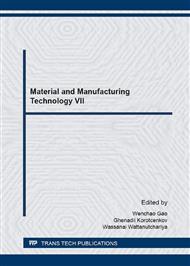p.114
p.118
p.123
p.128
p.133
p.138
p.147
p.152
p.157
Defect Reduction in the CO2 Laser Cutting of Glassware Rim
Abstract:
Defects in glassware are unacceptable in terms of product strength and aesthetics. The unsmooth cut rim of glassware can often be found in the laser trimming of excessive part after blow molding process. Such defect is basically not safe to use and has to be rejected from the production, thereby inevitably increasing the manufacturing cost and time. Hence, this research aims to reduce the defect in glassware rim induced by the laser cutting process. A wine glass was used as a workpiece sample in this study. Laser power, laser cutting time and workpiece rotational speed were tested and optimized to reduce the defects by using the response surface methodology. The optimum condition for the laser cutting of wine glass was found to be 225-W laser power, 2.4-s cutting duration and 335-rpm rotational speed.
Info:
Periodical:
Pages:
133-137
Citation:
Online since:
September 2016
Authors:
Keywords:
Price:
Сopyright:
© 2016 Trans Tech Publications Ltd. All Rights Reserved
Share:
Citation:


